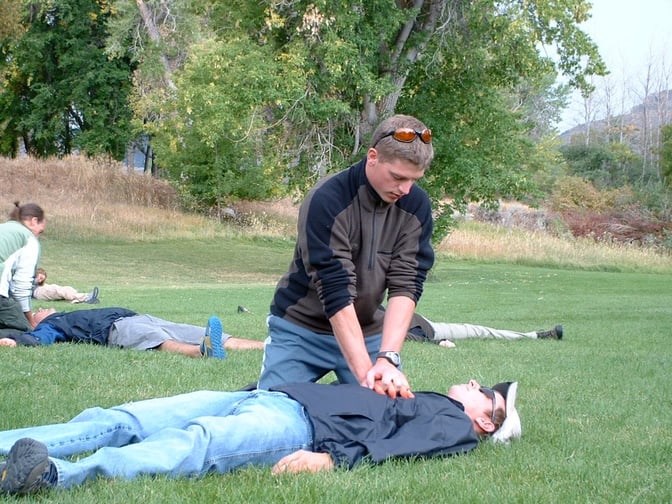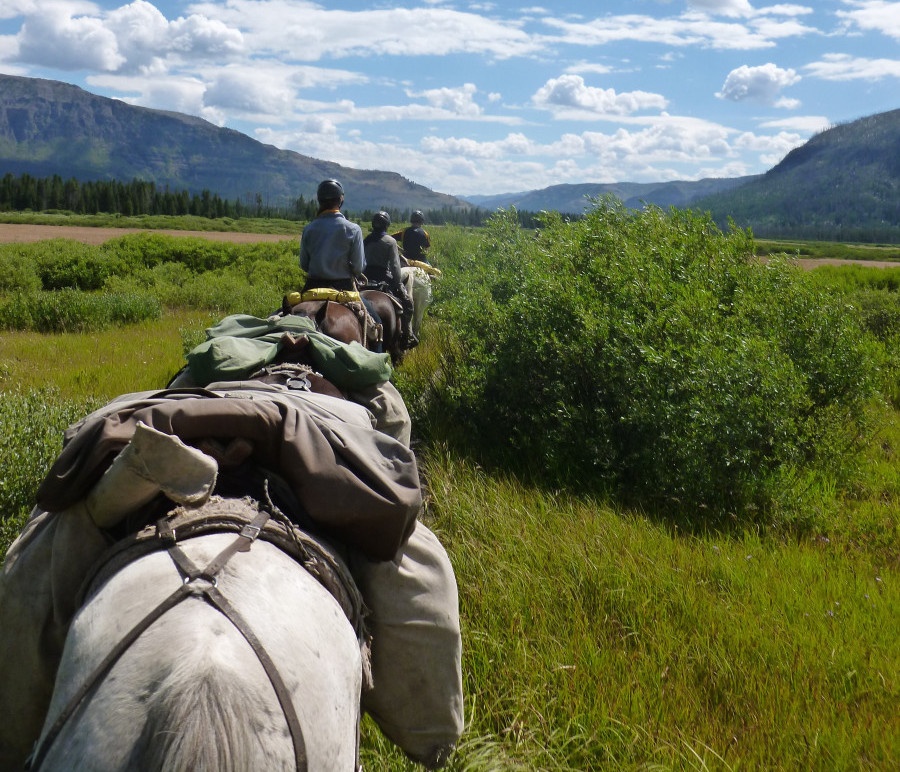
While walking a trail to a local rock climbing area you notice a person in the group just ahead collapse. Quickly, someone is kneeling at the patient’s side, fingers on the carotid pulse while they yell at him. Even from a distance you can see the patient is gray in color with blue lips. The rescuer aggressively removed the patient’s pack and began chest compressions. You estimate less than 30 seconds passed before CPR was started.
SOAP Report
Subjective
The patient is a 60-year-old male who collapsed while walking and is in cardiac arrest.
Objective
Patient Exam
The patient was not submerged and has no apparent injuries.
Vital Signs
|
Time |
11:00 AM |
|
Level of Responsiveness (LOR) |
Unresponsive |
|
Heart Rate (HR) |
absent |
|
Respiratory Rate (RR) |
absent |
|
Skin Color, Temperature, Moisture (SCTM) |
gray skin and blue lips |
|
Blood Pressure (BP) |
unobtainable |
|
Pupils |
not assessed |
|
Temperature (T°) |
not taken |
History
|
Symptoms: |
Unavailable |
|
Allergies: |
Unavailable |
|
Medications: |
Unavailable |
|
Pertinent Hx: |
Unavailable |
|
Last in/out: |
Unavailable |
|
Events: |
Unavailable |
Pause here!
What is your assessment and plan? Take a few minutes to figure out your own assessment and make a plan before you read further.

Assessment
- Patient is in cardiac arrest.
- There is no sign of injury, no mechanism for spine injury.
Plan
- Continue CPR
- Initiate access to AED, Advanced Life Support and evacuation
- Move patient onto a pad. Use clothing to insulate him (no sleeping bag available)
Anticipated problems
-
Continuing CPR during a litter carry will be very difficult. If patient awakes, we will need to keep him warm (the weather is cool, the ground cold). We may need to start rescue breathing with the chest compressions.
Comments
These comments are from a person who was on the scene of the actual event that this case study is based on.
“The CPR looked nothing like what I expected or had practiced. For the first minute the person giving chest compressions (a physician) did >100 compressions/minute and no breaths. The compressions were amazingly deep. I know we practiced how deep to push but now I really know what it looks like. He paused very briefly (I think he checked for a pulse) then did >100 compressions and no breaths for another minute. He was focused on the patient and said nothing while he did compressions.”
“The patient made guttural noises with each compression (that was also unexpected). After the second or third set of compressions (I'm assuming because he found a pulse) the doctor shook the patient vigorously and yelled the patient's name. At that point the patient took a huge gasping breath, opened his eyes and spoke.”
Comments from NOLS Wilderness Medicine:
This is a great example of two hallmarks of an effective response to cardiac arrest; early recognition and early and effective compressions.
Early recognition includes scene size-up, in this case a witnessed collapse, and the check for responsiveness and ABC’s that are part of the initial assessment. Assessing a pulse in the patient who may have a cardiac arrest is challenging, so we also look for "signs of life" (coughing, breathing, movement) in the patient.
Early and effective compressions are a key to success. Start compressions as soon as cardiac arrest is recognized. “Push hard, push fast” – with minimal to no interruptions in the compressions, at least 2" deep, lower half of sternum, complete recoil, minimum rate of 100/min. It’s clear the doctor who was giving the compressions knew this – he was focused and relentless until the patient awoke. We can make an educated guess that the early and aggressive compressions kept the brain alive and allowed the heart to resume pumping.
In the Circulation, Airway, Breathing (CAB) approach of urban CPR, the common cause of cardiac arrest is the heart, thus the emphasis on chest compressions. If the collapse is witnessed there is enough oxygen in the blood to preserve heart and brain function for a few minutes if it is circulated with effective chest compressions. It’s even okay to do compression-only CPR. But in the wilderness, it may be more likely for cardiac arrest to be secondary to hypoxia from airway obstruction (avalanche, drowning). These people, and those who have been in cardiac arrest for more than a few minutes, benefit from rescue breathing: combine compressions with rescue breathing (mouth-to-mouth or mouth-to-mask) in a 30:2 ratio.
Two other hallmarks of effective response to a cardiac arrest – early AED and early access to Advanced Life Support (ALS) - were not possible in this wilderness scenario, but the responders called 911 immediately and initiated the response that would bring the AED and ALS as soon as possible to the patient. Where is your nearest AED?
CPR is not a pretty sight. Effective compressions are deep, the patient’s skin color is awful, guttural sounds and vomit are common. This should not deter the rescuer.
The success rate from out-of-hospital cardiac arrest remains low. Statistics for wilderness CPR are dismal. But for miracles like this to happen, the people on the scene, like this physician and the WFR trained companions, need to recognize the cardiac arrest immediately and immediately start “pushing fast and hard.”
What Happened?
The patient collapsed at 11:00 am. The companions were able to call 911 from the scene. After the patient awoke they completed the patient assessment (which had stopped in the initial assessment phase) moved the patient onto a pad, kept him warm and checked vital signs. Paramedics arrived at 12:00 noon. The patient was evacuated by helicopter at 12:30. He had remained responsive since awakening. The patient had surgery on several blocked coronary arteries and has recovered well.
Is your CPR training current? Could you have reacted as quickly as these rescuers?
Keep your skills fresh: Recertify with NOLS.
FAQs: CPR for Cardiac Arrest
What is cardiac disease?
Cardiac disease is a broad term used to describe a range of diseases that affect the heart, such as coronary artery disease, heart failure, heart rhythm problems (arrhythmias), heart infections, and congenital heart defects such as an enlarged heart.
Prominent manifestations of these diseases involve narrowed or blocked blood vessels that can lead to cardiac arrest and heart attack. Managing risk factors like high blood pressure, high cholesterol, and avoiding a sedentary lifestyle is crucial for preventing these conditions.
Cardiac disease can present “atypically” (e.g., fainting, nausea, vomiting, back pain, altered mental status, weakness, and shortness of breath without chest pain) in anyone, including women, older adults, and people with diabetes.
“Atypical” is a misleading term, as these “atypical” presentations may be more common than the “typical” signs and symptoms portrayed in film or television.
Heart Atttack vs Cardiac Arrest: What is the difference between cardiac arrest and a heart attack?
A heart attack and cardiac arrest are both serious heart conditions, but they are different in their causes and manifestations.
What is a heart attack?
A heart attack (myocardial infarction) occurs when blood flow to a part of the heart is blocked, typically by a blood clot in a coronary artery. This blockage prevents oxygen-rich blood from reaching that part of the heart muscle, causing it to become damaged or die.
Without emergency treatment, a heart attack can lead to severe complications, including heart failure, arrhythmias, and even death.
Immediate medical intervention is crucial to restore blood flow, minimize heart damage, and improve the chances of survival.
Heart attacks can develop over time with warning signs, but they can also happen suddenly, often triggered by physical exertion, emotional stress, or an existing heart condition. Left untreated, a heart attack may progress quickly to cardiac arrest.
What is Cardiac Arrest?
Cardiac arrest is a sudden and severe medical emergency where the heart stops beating properly and pumping blood effectively.
Ventricular fibrillation is a common cause of cardiac arrest. This occurs when the heart’s electrical system malfunctions, leading to an irregular or absent heartbeat. The heart is unable to pump blood to the brain, lungs, and other vital organs.
Without immediate treatment, such as cardiopulmonary resuscitation (CPR) and the use of an automated external defibrillator (AED) if available, cardiac arrest can lead to death within minutes. Sudden cardiac arrest may occur suddenly and without warning, often triggered by an existing heart condition or other factors.
What are the symptoms and signs of a heart attack?
- Chest pain or discomfort. Pressure, squeezing, fullness, or pain in the center or left side of the chest.
- Pain or discomfort in other areas such as the arms, back, neck, jaw, or stomach.
- Shortness of breath that can occur with or without chest discomfort.
Nausea, vomiting, or indigestion. - Lightheadedness or dizziness.
- Cold sweat.
- Fatigue or unusual tiredness even without exertion, especially common in women.
- Denial, or conversely, an impending sense of doom.
What are the symptoms and signs of cardiac arrest?
- Sudden collapse.
- Loss of consciousness, unresponsive to touch or sound.
- No pulse, no detectable heartbeat.
- Absence of normal breathing or presence of gasping sounds (agonal breathing).
- Pale or bluish skin due to lack of oxygen.
- Lack of movement or other signs of life.
How is a heart attack treated?
Immediate Response
- Call emergency medical services immediately.
Medications
- Aspirin: To prevent further clotting.
- Nitroglycerin: To reduce heart workload and improve blood flow.
- Thrombolytics (clot-busting drugs): To dissolve the clot blocking blood flow to the heart.
- Other medications: To manage pain, blood pressure, and other conditions.
Medical Procedures
- Angioplasty & Stenting: To open blocked arteries.
- Coronary Artery Bypass Surgery: To create a new path for blood to flow to the heart.
Ongoing Treatment
- Lifestyle Changes: Diet, exercise, smoking cessation.
- Ongoing Medications: To manage cholesterol, blood pressure, and other risk factors.
- Cardiac Rehabilitation: To help the patient recover and prevent future heart problems.
What is the first aid treatment for cardiac arrest?
Immediate Response
- Reduce Patient Anxiety & Activity: Place the patient in a position of comfort. Ideally, avoid having the patient walk.
- Cardiopulmonary Resuscitation (CPR): Begin CPR to maintain blood flow to the brain and vital organs. Administer oxygen if available. Cardiac arrest is treated with immediate interventions like defibrillation to restart the heart and administration of antiarrhythmics via IV.
- Defibrillation: Use an automated external defibrillator (AED) to restore a normal heartbeat
- Medications: Support the patient with their personal medications, which commonly include:
- Nitroglycerin at 0.4 mg under the tongue (if systolic BP > 100 or radial pulse is present and no erectile dysfunction medication has been taken for 48 hours), with a common limit of 3 doses per episode.
- Aspirin at a usual dose of 325 mg, every 24 hours.
When should a patient with cardiac chest pain be evacuated?
Evacuate all patients with suspected cardiac chest pain or cardiac symptoms.
Rapidly evacuate any patient with a new onset of chest pain that is not clearly musculoskeletal and any patient with chest pain that is not relieved as expected by rest and nitroglycerin.
What are the guidelines for evacuating a patient with suspected cardiac chest pain?
- Ensure the patient is stable, calm, comfortable, and monitored.
- Use appropriate lifting techniques to avoid additional strain. It is best for a patient with a suspected cardiac issue to avoid any exercise, including walking, when possible.
- Transport to the nearest medical facility as quickly and safely as possible.
- Provide continuous monitoring and oxygen during transport.
Should you perform CPR when someone is in cardiac arrest?
Yes, you should perform CPR when someone is in cardiac arrest. CPR helps maintain blood flow to the brain and vital organs until professional medical help arrives and can potentially save the person’s life.
Performing CPR significantly increases the chances of surviving sudden cardiac arrest.
What are the CPR steps?
- Check responsiveness.
- If unresponsive, call for emergency medical help (911 in the U.S.) and send someone for an A.E.D.
- Assess for a carotic (neck) pulse for no more than 10 seconds. If no pulse, begin chest compressions:
- Place hands in the center of the chest on the lower half of the sternum.
- Push hard and fast at a rate of 100-120 compressions per minute.
- Effective CPR can prevent sudden cardiac death.
- Give rescue breaths (if trained):
- Open the airway using the head-tilt, chin-lift method (most common) or using the jaw-thrust if you suspect they could also have a spinal injury (less common).
- Give 2 breaths after every 30 compressions. Look for chest rise and fall, and reposition if you do not see chest rise and fall after the first breath.
- Continue CPR until professional help arrives or the person shows signs of life.
What is the CPR ratio for cardiac arrest?
The CPR ratio for cardiac arrest is 30 chest compressions to 2 rescue breaths if you have been trained to do both components.
Hands-Only CPR is another form of CPR where only compressions are administered, and for this form of CPR, continuous compressions at a rate of 100-120 compressions a minute is the goal.
What are the differences between CPR for adults, children, and infants?
- CPR for Adults: 30 compressions to 2 breaths, at least 2 inches deep.
- CPR for Children: 30 compressions to 2 breaths (single rescuer), about 2 inches deep; 15 compressions to 2 breaths (two rescuers).
- CPR for Infants: 30 compressions to 2 breaths (single rescuer), about 1.5 inches deep; 15 compressions to 2 breaths (two rescuers).
An easy way to remember the depth, regardless of the patient’s age, is one third the depth of the chest.
What is the golden rule of CPR to ensure high-quality chest compressions?
The golden rule of CPR is to ensure high-quality chest compressions: push hard and fast in the center of the chest, with a compression rate of 100-120 compressions per minute and a depth of at least 2 inches for adults.
Written By
Gates Richards
Gates Richards has been involved in outdoor education and EMS since the early '90s. Over the years he's worked outdoor programming throughout the Rockies, Pacific Northwest and Alaska. He's worked urban EMS in DC, WA, CO and WY. Gates began teaching for NOLS Wilderness Medicine in 1998 and has been awarded the Wilderness Medical Society's Warren Bowman award for contributions to wilderness medicine by a non-physician as well as the National Collegiate EMS Foundation's Distinguished Service Award. He was the former Associate Director and is currently a NOLS Wilderness Medicine Faculty member.



